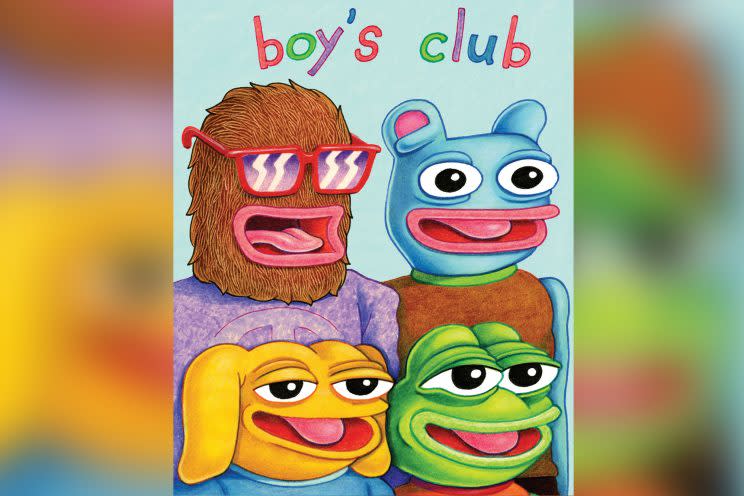Reclaiming Pepe: Can the cartoon frog return to its peaceful roots?

There are approximately 250 images, characters and illustrations in the Anti-Defamation League’s database of hate symbols.
Last month, a droopy-eyed cartoon frog named Pepe became one of them. Over the past year, Pepe the Frog has become a regular fixture of racist and anti-Semitic Internet memes — many of them supporting Republican Donald Trump’s campaign.
But he wasn’t always the mascot of the alt-right.
“It’s completely insane that Pepe has been labeled a symbol of hate, and that racists and anti-Semites are using a once peaceful frog-dude from my comic book as an icon of hate,” artist Matt Furie, who first introduced his droopy-eyed amphibian to the world 10 years ago with the debut of his comic book “Boys’ Club,” wrote last week in an open letter at Time Ideas.
“It’s a nightmare,” Furie continued, lamenting Pepe’s inexplicable evolution from “blissfully stoned frog” to racist calling card — “and the only thing I can do is see this as an opportunity to speak out against hate.”
The ADL agreed. The nonprofit is now teaming up with Furie to “#SavePepe” from the hatemongers who’ve co-opted him.
In addition to a somewhat terrifying comic depicting Pepe’s transformation into a hate symbol, Furie released this week a new drawing of his beloved frog alongside a speech bubble that reads, “Be nice, man.”
It’s those kinds of positive images of Pepe that the ADL plans to encourage others to share.
“The more we can try to encourage people to create positive versions of [Pepe],” the more the ADL hopes those positive images will balance out the negative ones, Oren Segal, director of the ADL’s Center on Extremism, told Yahoo News.
“Will it override the hate speech? We’ll see, the jury is out,” he said, adding “I think it’s worth exploring.”
Segal admitted that such an effort to reframe a hate symbol “is very much uncharted territory for us.”
But while returning Pepe to his peaceful origins might seem like an uphill battle, he said, “We have to try. We’re going to try.”
“The ADL’s fundamental role is to try to imagine a world without hate, to combat hatred and bigotry wherever it is,” he said.
Though the rehabilitation of Pepe’s image is still in its early stages, Segal said he’s encouraged by the grassroots movement to reclaim another recent addition to the ADL’s database: the triple parenthesis — {{{ }}} — known as the “echo.”
Used to identify Jews, or those perceived as Jewish, online, the echo first emerged as a sort of digital Star of David patch in 2014. But it wasn’t until this spring, after white supremacists, anti-Semites and other extremists began aggressively employing the triple parenthesis to harass certain Jewish journalists on social media, that the ADL officially declared the echo a hate symbol.
By the time the echo was entered into the ADL’s database, however, many Jewish journalists and others on Twitter had started to reappropriate it, adding the triple parenthesis to their own names in a display of solidarity with those who’d been harassed.
This has hardly stopped extremists from using the echo to single out Jews online — as is evidenced by a quick scroll through the Twitter feed of former Ku Klux Klan leader, and current Senate candidate, David Duke.
Eminem is a puppet of (((Paul Rosenberg))) and (((Jimmy Iovine))) – For years Eminem has been poisoning the minds of our youth. #rigged pic.twitter.com/xECYJ0HBsK
— David Duke (@DrDavidDuke) October 19, 2016
But by reclaiming ownership of the echo, Segal suggested, Twitter users may have at least managed to diffuse the negative connotation associated with the symbol so that it carries slightly less weight.
And while Segal acknowledges that the echo is not nearly as widespread as Pepe the Frog, he looks to the efforts to reclaim the triple parenthesis as an example of how to “fight bad speech with good speech.”
Segal said he knows there are those who might think “the notion of reclaiming a meme like this is naive.” But, he insists, Pepe is more than just a silly frog meme, and the effort to reclaim him “speaks to the broader work of the ADL, in terms of exposing racism, antisemitism and bigotry of all kinds.”
One of the ADL’s objectives, he continued “is to talk about how hatred and bigotry spreads.”
“Today hatred and bigotry doesn’t just spread through cross burnings on people’s lawns, it spreads online and social media in ways people couldn’t have imagined years ago,” he said.
So while, “Yes, it’s a frog meme,” said Segal, as long as “it’s being used by hate groups to try to harass and intimidate … [it’s] not an option to remain silent.”


